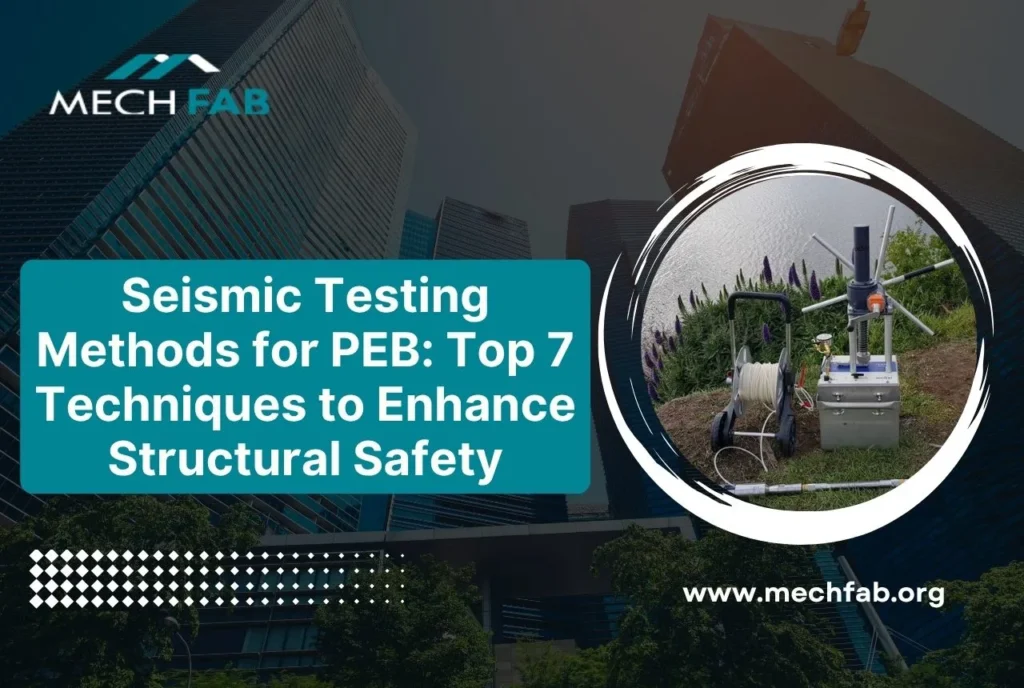Seismic testing methods for PEB are crucial in today’s construction landscape, where Pre-Engineered Buildings (PEBs) have become increasingly popular due to their cost-efficiency, speed of installation, and design flexibility. These steel-based structures are now widely used in industrial, commercial, and institutional sectors, especially in seismically active regions. However, given the growing frequency and intensity of earthquakes, ensuring the seismic safety of PEBs is critical.
Seismic testing plays a crucial role in validating the structural integrity of PEBs under earthquake loads. Without proper assessment, even well-designed buildings may face catastrophic damage during seismic events. Earthquakes can induce lateral forces, ground accelerations, and dynamic shifts that significantly affect the behavior of steel structures.
This blog explores 7 proven seismic testing methods for PEB, offering insights into their application and benefits. From simulation tools to real-time monitoring systems, these techniques are essential for manufacturers, structural engineers, and construction professionals striving for earthquake-resistant building designs.
Understanding Seismic Testing Methods for PEB
Seismic testing methods for PEB (Pre-Engineered Buildings) focus on analyzing how these steel structures respond to dynamic ground movements during earthquakes. Unlike conventional testing—which assesses static load-bearing capabilities—seismic testing evaluates a structure’s ability to absorb, dissipate, and transfer seismic energy without failure.
The primary parameters examined include lateral displacement, base shear, and response acceleration. These metrics help predict the stress levels and deformation patterns a PEB may experience during a seismic event. Engineers rely on established seismic design codes such as IS 1893 (Part 1): 2016 and international standards (like ASCE 7 and Eurocode 8) to guide testing protocols and structural evaluations.
Testing not only ensures code compliance but also enhances the overall safety, durability, and functionality of the building. Additionally, it allows optimization of steel consumption, frame design, and foundation alignment based on site-specific seismic risks. With proper testing, stakeholders can significantly minimize the potential for loss of life, property damage, and costly retrofits post-construction.
7 Proven Seismic Testing Techniques for PEB Structural Integrity
1. Equivalent Static Lateral Force Method
This technique is one of the most widely used in the early stages of seismic design. It applies a mathematical model based on base shear calculations (VB = Ah × W), where Ah represents the design horizontal acceleration and W the seismic weight of the structure.
Key factors include:
- Zone factor (Z) for seismic intensity
- Importance factor (I) for building function
- Response reduction factor (R) based on structural ductility
Ideal for preliminary analysis, this method simplifies complex dynamic effects into an equivalent static force. While useful, it may not fully capture higher mode responses in irregular or tall PEBs.
2. Non-Destructive Testing (NDT) for Seismic Assessment
NDT methods are crucial for evaluating material integrity without causing damage. Common NDT techniques include:
- Ultrasonic Testing (UT): Identifies internal flaws in steel members.
- Magnetic Particle Inspection (MPI): Detects surface-level cracks, especially in welded joints.
- Radiographic Testing (RT): Examines weld quality and internal discontinuities.
- Ground Penetrating Radar (GPR): Assesses foundation anchorage and connection systems.
These tests ensure that critical components of the PEB can withstand dynamic seismic loads without hidden vulnerabilities.
3. Dynamic Response Spectrum Analysis
An advanced computational method, this technique uses earthquake records to simulate building behavior. It generates response spectrum curves representing maximum responses (acceleration, displacement, velocity) for different periods.
Applications:
- Structural modeling with tools like STAAD Pro V8i and ETABS
- Comparative analysis of various PEB frame types
- Selection of optimal design configuration for specific seismic zones
This method provides a more detailed understanding of dynamic behavior compared to static analysis.
4. Load Testing and Performance Evaluation
In this method, physical loads are applied to the PEB structure to simulate seismic forces.
Key practices include:
- Fatigue Testing: Evaluates performance under repeated seismic-like stress.
- Wind-Seismic Interaction Testing: Assesses the combined effects of lateral forces.
- Full-scale Load Testing: Real-time structural response monitoring to measure deflection, cracking, and yield points.
This testing validates theoretical calculations with actual performance data.
5. Structural Health Monitoring (SHM) Systems
SHM systems involve the integration of smart sensors within the PEB to enable continuous structural monitoring.
Benefits:
- Real-time tracking of stress, strain, and vibrations
- Immediate alerts during seismic activity
- Long-term data for trend analysis and predictive maintenance
- Post-earthquake structural damage mapping
SHM enhances the resilience and longevity of PEB structures in seismic regions.
6. Visual Inspection and Condition Assessment
Although basic, visual inspection remains a fundamental technique for ongoing seismic readiness.
Checklist includes:
- Surface cracks or weld failures
- Deformations in columns or trusses
- Corrosion, especially at joints and anchors
- Loose or misaligned connections
Regular inspections, combined with documentation and expert evaluation, form the first line of defense in seismic safety protocols.
7. Advanced Seismic Simulation Testing
This method involves shake table testing or hybrid simulation to replicate actual earthquake forces on structural models or components.
Applications:
- Performance-based seismic design validation
- Study of energy dissipation through dampers and flexible joints
- Evaluation of deformation patterns under controlled seismic inputs
It’s one of the most reliable techniques for high-risk zones and research-based design optimization.
Frame Systems and Seismic Resistance in PEB
The choice of framing system significantly affects how a PEB responds to seismic loads. Common configurations include:
- Moment-Resisting Frames (MRF): Offer strong lateral resistance through rigid joints
- Braced Frames (BF): Use diagonal bracing to redirect lateral forces efficiently
- Eccentrically Braced Frames (EBF): Provide better ductility and energy absorption
- Dual System Frames (DSF): Combine MRF and shear walls for enhanced performance
- Shear Walls: Reinforce stability by distributing seismic forces across vertical planes
- Composite Frames: Integrate steel and concrete to improve load-bearing and energy dissipation
Selecting the right frame system is integral to the success of seismic testing and overall PEB resilience.
Industry Leadership: MECHFAB’s Approach to Seismic Testing
With over 47 years of excellence, MECHFAB leads the PEB industry in Northeast India. Known for delivering over 600 earthquake-resistant buildings, the company integrates all key seismic testing methods for PEB in its design and manufacturing processes.
Their commitment to structural safety, code compliance, and cutting-edge technologies solidifies their reputation as the best PEB company in Guwahati and Assam.
Final Thoughts on Seismic Testing Methods for PEB
In seismic-prone regions, understanding and applying the right seismic testing methods for PEB is non-negotiable. These 7 techniques—from static force calculations to shake table simulations—offer a comprehensive framework for ensuring that PEBs stand strong when earthquakes strike.
With industry leaders like MECHFAB setting high standards, the future of earthquake-resilient steel buildings looks safer than ever.






